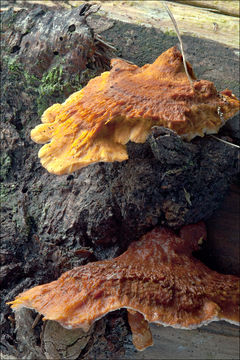صورة Pycnoporellus fulgens (Fr.) Donk 1971

الوصف:
Slo.: bliskov gostoluknjiar - syn.: Hydnum fulgens Fr., Polyporus fibrillosus Karst - Habitat: a small opening (under power lines) in mixed wood; Picea abies and Fagus sylvatica dominant trees; old overgrown river deposits, flat terrain, calcareous ground, an open place but not much sun because of a high mountain southeast of the place, high air humidity; moderately humid ground, exposed to direct rain, average precipitations ~ 3.000 mm/year, average temperature 6-8 deg C, elevation 550 m (1.800 feet), alpine phytogeographical region.Substratum: dead, fallen Picea abies log, partly still in bark, lying on ground.Place: Lower Trenta valley, left bank of river Soa, slightly upstream of farmhouse 'Otokar', Trenta 4, East Julian Alps, Posoje, Slovenia EC Comments: This find was initially determined (with reservations, spore dimensions and substrate definitely did not fit) as Abortiporus biennis. Based on discussion on MO (Ref.: 1) the determination was corrected to Pycnoporellus fulgens. The new determination solves the problems with spore dimensions and substratum.Pycnoporellus fulgens is a rare continental species in Europe apparently restricted to the natural area of Picea abies and distinctly restricted to old forests with high continuity (Ref.: 2). It is more frequent in North America and Canada. It appears that during last decades it shifts its main distribution area from northern regions to southern. Also it seems that its occurrence is increasing, at least in Switzerland (Ref.: 4. and 5.). Growing in a group of about ten pilei; pilei applanate to slightly effused-reflexed, broadly attached; semicircular to slightly dimidiate, soft, but solid and pliant, with softer, wet surface; pilei dimensions: up to 10 cm wide, projecting up to 6 cm off the substratum and up to 1.8 cm thick; distinct lateral stipe absent; pore layer up to 6 mm thick; pore surface slowly discolors to pale brown-red when handled; 5% KOH reaction on trama and pileus surface instant, strong, dark purple red; on pore layer brick red; smell none, taste at the beginning mildly mushroomy later somewhat unpleasant; SP whitish-yellowish, oac909. Several Fomitopsis pinicola pilei were also present on the same log, which is characteristic too for Pycnoporellus fulgens (Ref.: 4).Protected according to Uredba o zavarovanih prostoiveih vrstah gliv, Uradni list RS, t. 58/2011 (Regulation of protected wild fungi, Official Gazette of Republic Slovenia, no. 58/2011), (2011). on red list Ref.:(1) Id'ed by Susanne Sourell (suse) on Mushroom Observer. See MO observation #185610.(2) L. Ryvarden, R.L. Gilbertson, European Polypores, part 2., Synopsis Fungorum 7., Fungiflora A/S (1993), p 593. (3) A. Bernicchia, Polyporaceae s.l., Fungi Europaei, Vol. 10., Edizioni Candusso (2005), p 478. (4) B. Senn-Irlet, Der Leuchtende Weichporling - eine Piltzart auf dem Vormarsch, Wald und Holz, 11/05, WSL, Switzerland, p 34.(5) G.J. Krieglsteiner (Hrsg.), Die Grosspilze Baden-Wrttembergs, Band 1., Ulmer (2000), p 573.
مشمول على الصفحات التالية:
- Life
- Cellular
- Eukaryota (حقيقيات النوى)
- Opisthokonta
- Nucletmycea
- Fungi
- Dikarya
- Basidiomycota (دعاميات)
- Agaricomycetes (غاريقونانية)
- Polyporales (متعددات الأبواغ)
- Fomitopsidaceae (شبيهات السمية)
- Pycnoporellus
- Pycnoporellus fulgens
هذه الصورة ليست واردة في أي مجموعات.
معلومات المصدر
- ترخيص
- cc-by-nc-sa-3.0
- حقوق النشر
- 2016 Dr. Amadej Trnkoczy
- مصور
- Dr. Amadej Trnkoczy
- النص الأصلي
- ملف الوسائط الأصلي
- زيارة المصدر
- موقع الشريك
- CalPhotos
- ID


